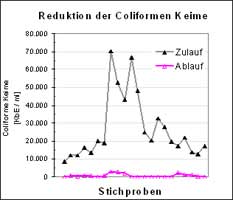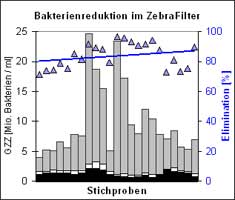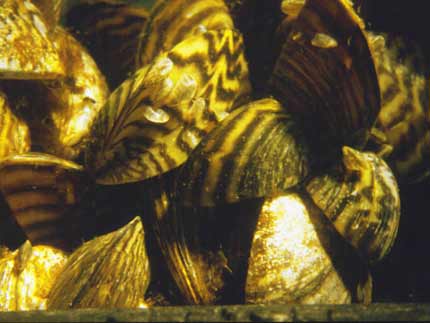|
research
|
Background: Importance of degermination of wastewater
Wastewater treatment plants do still pollute rivers with pathogen microbes; also bacteria with multiple resistance against antibiotics a detected increasingly.
Mandatory threshold values must be kept for bathing water according to European Guidelines. Following an amendment-proposal in 2002 of the (former) European Guideline 76/160/EEC (1975), mandatory values for the bacterial indicators Enterococcus and Escherichia coli are to be met. Especially in slow-flowing waters also the reduction of nutrients in dumped sewage treatment plant effluents must urgently be reduced in order to minimise the risk of eutrophication/over-fertilisation. During the filtration process nitrogen and phosphorous contained within suspended solids is removed. |
| |
|
| |
|
In practical experiments conducted at two municipal sewage treatment plants (Dresden Kaditz and Radeberg , Germany ), elimination of up to 99% of the bacteria was achieved. Removing other suspended matter additionally helps to protect waters against eutrophication/over-fertilisation.
The range of application as well as criteria for dimensioning the construction of larger scale treatment facilities could be deduced. |
| |
|
| |
| Experimental reactor of the research project: A reactor was constructed in which the water to be purified was led closely along pebble overgrown with mussels, arranged in several floors above each other. The baseplates of these floors served as baffles for a meandering upward flow. In this reactor the waste water of about 24 inhabitants was treated and analysed under practical conditions for several years at two municipal sewage treatment plants (Dresden Kaditz and Radeberg , Germany ).
|
|
Drawing of the reactor and some pebbles overgrown with mussels. Six floors arranged above each other resulted in a flow path of about 5 m length. This laboratory version for practical experiments held 150 litres and was fed with 0.5 to 2 litres of municipal waste water effluent per minute. |
| |
|
| |
Analysis of the content of bacteria The number of bacterial colonies on agar-plates only represents a very small fraction of the number of bacterial which actually exist in the sample. In addition to classic spreading on DEV nutrition agar according to DIN 38411 T5 [German Industrial Standards] a method of microscopic direct counting was chosen, which stains all existing bacteria with a fluorescent stain called DAPI (4',6-Diamidino-2-Phenylindol-dihydrochlorid). Stained cells may be counted - independently of their suitability for cultivation (PORTER & FEIG, 1980). For comparison: a total number of 10.000 to 1.000.000 bacteria is may be detected by direct counting in chlorinated and unchlorinated drinking water (SZEWZYK, 1996), and this is still hygienically safe.
|
| |
|
| |
Results: Degree of hygenisation and reduction of suspended matter
The ZebraFilter achieved an elimination of 90% of loads of 25 million cells/ml during a residence time of 90 minutes. Applying a residence time of 45 min, up to 80% of suspended matter was reduced to contents < 1 mg AFS/l using the first laboratory reactor which was structurally inconvenient. An even better elimination rate is expected using optimisation of the construction.
1 mg AFS corresponds to 0,01-0,03 mg P and 1,0-1,5 mg CSB, respectively.  
left : Coliforme bacteria in influent and effluent of the ZebraFilter during input of wastewater treatment plant effluent.
Numbers relate to colony forming units (cfu = KbE) per ml using plating technique on ENDO agar.
right : bacterial concentration in the input (grey columns) of the ZebraFilter, after passing 1000 mussels (white columns, overlapping) and in the output after passing 3000 mussels (black columns), as well as elimination rate (%) ( , right axis) after a retention time of 90 min. Note that the majority of the bacterial pollution is already eliminated during the first third of the flow path (passing 100 mussels). , right axis) after a retention time of 90 min. Note that the majority of the bacterial pollution is already eliminated during the first third of the flow path (passing 100 mussels).
Numbers relate to total number of bacteria [GZZ] using the DAPI-fluorescent stain + direct counting technique.
|
| |
|
| |
Discussion: Comparison with conventional purification procedures
In Germany it is still relatively unusual to degerminate or disinfect the effluent of municipal wastewater treatment plants at all. Most common is UV radiation, rarely ozone is used for disinfection and in single cases chlorine is used. Advantages and disadvantages of those methods as well as practical experience and maintenance costs are compared in ATV* leaflet M 205.
*ATV Abwassertechnische Vereinigung , German wastewater association,
see www.atv-dvwk.de
Using membrane filtration water is forced partly with pressure through ultra- or nano-porous membranes. Energy supply and regular exchange of membranes are necessary. Membrane filtration exceeds all other methods in efficiency and in costs...
Constructed wetlands (reed treatment plants) principally achieve comparably low bacterial contents but need far more building space (about 1 m2 per inhabitant) and far longer residence times (about 1-3 days). Still, the ZebraFilter is not supposed to conquer with constructed wetlands which are advisable under an ecological point of view. The ZebraFilter rather serves as a post treatment for conventional water purification methods in case of insufficient results.
So called biofilters do not serve for the retention of bacteria. They do not achieve concentrations of suspended matter < 5 mg AFS/l. Additionally backwashing of the filter is costly (BARJENBRUCH 1998 and 2000).
Sandfilters need a building space about 25 m2 per inhabitant compared with 0,01 m2 per inhabitant for the ZebraFilter.
UV radiation does not work in presence of suspended matter, while the ZebraFilter does work even in case of high loads of suspended solids and does even remove the suspended matter in the same step.
Ponds for post treatment are no longer common practice. Residence time in ponds is 1-5 days, compared with 50-90 min in the ZebraFilter.
Chlorinating and ozonating are nowadays unacceptable and are no longer generally applied for ecological reasons.
|
 © B. Ral
© B. Ral |
| |
|
| |
Advantages of the ZebraFilter
• no energy demand for the filtration
process (protection of the atmosphere)
• no demand of chemicals
• ecological process without hazardous
wastes
• no exchange of membranes:
mussels
clean and regenerate the filtration system
(gills) by their own
• very little building space:
about 1 m2 / 100 inhabitants
• low maintenance costs
• remaining waste is bio-degradable |
| |
|
| |
|
Risk assessment
Of course a biological system is never 100% calculable. The whole batch of mussels within a reactor may be harmed by poisoning, viruses or parasites. Coming supplies of mussels may be limited due to changes in limnic systems. It is also sure that the ZebraFilter can not achieve sterility, but can only reduce the number of pathogens below a threshold value. Nevertheless the advantages and low costs of this system suggest its application in certain fields.
In any case care must be taken not to introduce zebra mussels into regions where they did not exist before.
|
| |
|
| |
Conclusions and field of application
The ZebraFilter can principally compete with all comparable methods on the market as long as the water to be treated is within the following range of application:
• ammonia < 20 mg/l NH4 (peaks) or rather < 5 mg/l NH4 (continuous charge)
• pH 7.0 to 8.5; temperature 10 to 22°C, maximum change 5 K/h
• oxygen > 5 mg/l (in some cases 3 mg/l may be sufficient)
• cultivable number of bacteria (cfu) >500.000 KbE/ml or
total number of bacteria >10·106 cells/ml (DAPI-method)
• effluent only into waters, in which the zebra mussel did appear before, such as river Havel, river Elbe, river Rhein or in which zebra mussels can not proliferate (salt water, irrigation water for greens/lawn.
Zebra mussels may be easily collected from mass-incidence without violating aspects of environmental protection, or they may be rather be bred in aquaculture. Within the above range of application the mussels will survive and work for at least one year. |
| |
|
| |
Acknowledgements
I would like to thank the German ministry of research and development (BMBF) who funded the research project (No. 02 WA9619/0), Ms. Prof. Dr. rer. nat. habil. I. Röske for looking after it at the department of applied microbiology at the Technical University Dresden, but also Manuela Junge and Birgit Schulz for their help in counting bacteria.
Also I thank all those who have done research and work of persuasion for decades on the applicability and acceptance of constructed wetlands / reed water treatment plants. Thanks to those pioneers many hurdles for the method presented here have already been minimised. |
| |
|
| |
|
ATV-DVWK (ed.): Desinfektion von biologisch gereinigtem Abwasser, leaflet Merkblatt ATV-M 205 , 1998.
Barjenbruch M., Behrendt J., Boll R., Flemming H.-C.& Sieker , K.: Stand und Entwicklungstendenzen bei der Abwasserreinigung mit Biofiltern. KA - Wasserwirtschaft, Abwasser, Abfall 45 (5):929-935, 1998.
Barjenbruch M. et al.: Biofilter zur Abwasserreinigung. KA - Wasserwirtschaft, Abwasser, Abfall 47 (4):569-570, 2000.
FLEISHER J.M., SALMON R.L., JONES F., WYER M. & GODFREE A.F.: Predicting likelihood of gastro-enteritis from sea bathing: results from randomised exposure . The Lancet 344 (October 1 ): 905-909, 1994 .
Porter K.G & Feig Y.S.: The use of DAPI for identifying and counting aquatic microflora. Limnology and Oceanography 25 (5): 943-948, 1980.
Ral B. & Röske I. (submitted 1999, granted 2002). Verfahren und Anordnung zur Elimination von Pathogenitätsfaktoren (Bakterien und Viren) aus verunreinigtem Wasser. Deutsches Patent- und Markenamt. Anmeldung Nr. 19910278.C2.
Ral B. & Röske I. (2000). Elimination of bacteria from waste water using the filtering organism Dreissena sp. (zebra mussel). Proceedings of the World Filtration Congress WFC 8, April 3-7, 2000, Brighton/UK , 1, 123-126.
SCHULZ , B. (1998): Elimination von Bakterien aus Kläranlagenabflüssen mit Dreissena spec . am Beispiel der Kläranlage Dresden - Kaditz. Diplomarbeit im Rahmen des Projektes, Institut für Hydrobiologie der Fakultät Forst-, Geo-, Hydrowissenschaften, TU Dresden
Szewzyk U., 1996: In Mikrobiologie des Grund- und Trinkwassers, Weigert B. (Hrsg.), Wasserforschung e.V., D-10623 Berlin, ISBN 3-00-000651-6, S. 3-20.
|
| |
|
|